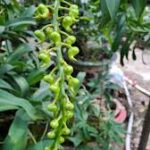
Sato Cymbidium orchids, renowned for their stunning blooms and lush foliage, require specific lighting conditions to thrive. Understanding how to optimize light exposure is crucial for cultivating healthy, vibrant orchids. This guide will explore the various aspects of light usage to enhance the growth of Sato Cymbidium orchids, covering everything from natural light requirements to artificial lighting solutions.
## 1. Understanding the Light Needs of Sato Cymbidium Orchids
### 1.1 Natural Habitat of Sato Cymbidium Orchids
Sato Cymbidium orchids are native to tropical and subtropical regions of Asia, where they typically grow in shaded environments such as forests. In their natural habitat, these orchids receive dappled sunlight filtered through the canopy of trees. This background is essential in understanding their light requirements, as they thrive in bright but indirect light.
### 1.2 Light Intensity and Quality
Light intensity refers to the amount of light that reaches the plant, while light quality pertains to the wavelengths of light that plants absorb for photosynthesis. Sato Cymbidium orchids prefer bright, indirect light, with an intensity ranging between 1,500 and 3,000 foot-candles. They can tolerate short periods of direct sunlight, particularly in the morning, but prolonged exposure can lead to leaf burn and stress.
## 2. Identifying Suitable Light Sources
### 2.1 Natural Light Sources
#### 2.1.1 Windows
Positioning Sato Cymbidium orchids near windows is an effective way to provide natural light. However, the type of window and its orientation can significantly affect light availability.
– **East-Facing Windows**: These windows receive morning sunlight, providing gentle light that is ideal for orchids. Placing your orchids here can enhance their growth without risking leaf damage.
– **South-Facing Windows**: South-facing windows offer strong sunlight throughout the day. If using these windows, ensure your orchids are a few feet away from the glass or utilize sheer curtains to diffuse the light.
– **West-Facing Windows**: Similar to south-facing windows, west-facing windows can deliver intense light in the afternoon. Again, consider placing your orchids further back or using curtains to mitigate the harshness of the light.
– **North-Facing Windows**: North-facing windows provide the least amount of light, which may not be suitable for Sato Cymbidium orchids unless supplemented with additional lighting.
#### 2.1.2 Natural Light Modifiers
To optimize natural light exposure, consider using:
– **Sheer Curtains**: These can diffuse direct sunlight while allowing sufficient brightness to reach the plants.
– **Reflective Surfaces**: Utilizing reflective surfaces or light-colored walls can help bounce light onto your orchids, enhancing their exposure.
### 2.2 Artificial Light Sources
In situations where natural light is insufficient or inconsistent, artificial lighting becomes essential for the health of Sato Cymbidium orchids.
#### 2.2.1 Types of Artificial Lights
1. **Fluorescent Lights**: These lights are energy-efficient and emit a spectrum of light suitable for plant growth. Cool white fluorescent bulbs are ideal for orchids.
2. **LED Grow Lights**: LED lights are becoming increasingly popular due to their energy efficiency and ability to emit specific wavelengths beneficial for plant growth. Full-spectrum LED grow lights are particularly effective for orchids.
3. **Incandescent Bulbs**: While these bulbs provide light, they generate a significant amount of heat and are less energy-efficient than fluorescent or LED lights. They are not recommended for orchids.
### 2.3 Positioning Artificial Lights
When using artificial lighting, the positioning of the lights is crucial for optimizing exposure.
– **Distance from Plants**: Place fluorescent lights about 12 to 24 inches away from the orchids, while LED lights can be placed closer, approximately 6 to 12 inches away, depending on their intensity.
– **Duration of Light Exposure**: Sato Cymbidium orchids typically require 12 to 16 hours of light per day. Use timers to maintain consistent light exposure, especially in regions with varying daylight hours.
## 3. Light Conditions Throughout the Year
### 3.1 Seasonal Changes
Light conditions can change dramatically throughout the year, influencing the growth patterns of Sato Cymbidium orchids.
– **Spring and Summer**: During these seasons, natural light is abundant. Monitor the orchids closely to ensure they are not receiving too much direct sunlight, as higher temperatures can lead to leaf burn.
– **Fall and Winter**: As daylight hours decrease, consider supplementing with artificial light to maintain consistent exposure. Orchids may enter a resting period during these months, and reduced light can signal them to slow growth.
### 3.2 Adapting to Changing Light Conditions
To ensure optimal growth year-round, it is essential to adjust the care routine according to seasonal changes.
– **Monitor Light Levels**: Use a light meter to check light levels in the orchids’ environment and adjust positioning as needed.
– **Adjust Watering and Fertilization**: Reduced light exposure may require adjustments in watering and fertilization practices, as orchids may not be actively growing during these months.
## 4. Signs of Improper Light Exposure
Understanding the signs of improper light exposure is critical for maintaining the health of Sato Cymbidium orchids.
### 4.1 Symptoms of Insufficient Light
– **Stretched Growth**: If your orchids are reaching toward the light source or exhibiting elongated stems, this may indicate that they are not receiving enough light.
– **Slow Growth**: Insufficient light can lead to a noticeable slowdown in growth and blooming.
### 4.2 Symptoms of Excessive Light
– **Leaf Burn**: Brown, crispy leaf edges or spots indicate too much direct sunlight.
– **Fading Colors**: Flowers may lose their vibrant colors or appear washed out under excessive light exposure.
## 5. Tips for Maximizing Light Exposure
### 5.1 Rotate Your Orchids
To ensure even light exposure, regularly rotate your orchids. This practice helps all sides of the plant receive equal light, promoting uniform growth and preventing lopsidedness.
### 5.2 Use Reflective Surfaces
Incorporate reflective surfaces, such as mirrors or light-colored walls, to enhance the overall light intensity that reaches your orchids. This technique is particularly beneficial in spaces with limited natural light.
### 5.3 Monitor Temperature
When optimizing light exposure, always monitor temperature changes. Artificial lights can generate heat, which may stress your orchids if not managed correctly. Ensure that your orchids are not exposed to excessive heat, which can lead to wilting and damage.
## 6. Adjusting for Specific Growing Conditions
### 6.1 Indoor Growing Environments
Indoor growing conditions often require more stringent light management. Consider the following:
– **Using Grow Tents**: These controlled environments can help regulate light and temperature, providing optimal conditions for Sato Cymbidium orchids.
– **Light-Reflective Materials**: Line the interior of your grow tent with light-reflective materials to maximize light distribution.
### 6.2 Outdoor Growing Environments
For those growing Sato Cymbidium orchids outdoors, be mindful of the following:
– **Location**: Choose a location that provides filtered light, such as beneath a tree canopy or a shaded patio.
– **Seasonal Changes**: Be prepared to move your orchids indoors or provide additional shade during peak summer months to prevent leaf burn.
## 7. Conclusion
Optimizing light exposure is essential for the healthy growth of Sato Cymbidium orchids. By understanding their light requirements and implementing the strategies discussed in this guide, you can create an environment that promotes vibrant blooms and lush foliage. Remember to monitor light conditions regularly, adjust care practices according to seasonal changes, and address any signs of improper light exposure promptly. With dedication and attention to detail, your Sato Cymbidium orchids will flourish, bringing beauty and elegance to your home or garden.
Whether you’re an experienced grower or just starting your journey with orchids, understanding how to use light effectively is the key to unlocking the full potential of these remarkable plants.
# Utilizing Light to Optimize the Growth of Sato Cymbidium Orchids: Advanced Techniques
In the world of orchid cultivation, light plays a pivotal role in the growth and blooming of Sato Cymbidium orchids. These beautiful plants thrive under the right light conditions, which can greatly enhance their health, vigor, and flowering potential. In this second part of our guide, we will delve deeper into advanced techniques for utilizing both natural and artificial light to create optimal growth conditions for your Sato Cymbidium orchids. We’ll explore the importance of light spectrum, timing, and environmental adjustments to ensure these exquisite flowers flourish in your care.
## 1. Understanding the Light Spectrum
### 1.1 The Importance of Light Wavelengths
Different wavelengths of light have varying effects on plant growth. Understanding the light spectrum is crucial for optimizing the conditions in which Sato Cymbidium orchids thrive.
– **Blue Light (400-500 nm)**: This range promotes vegetative growth and is essential for photosynthesis. It encourages strong root development and lush foliage, making it vital during the early stages of plant growth.
– **Red Light (600-700 nm)**: Red light plays a significant role in flowering and fruiting. For orchids, providing adequate red light is crucial for stimulating blooming. Combining red light with blue light can lead to optimal growth and flowering.
– **Green Light (500-600 nm)**: While often considered less important, green light penetrates deeper into the leaf structure, enhancing overall photosynthesis and plant health.
– **Far-Red Light (700-800 nm)**: This light spectrum influences plant height and flowering time. While not essential, far-red light can be beneficial for stimulating certain growth responses.
### 1.2 Full-Spectrum Lighting
To mimic natural sunlight, using full-spectrum lighting can be advantageous. Full-spectrum bulbs emit light across the entire spectrum, providing the necessary wavelengths for photosynthesis, growth, and flowering. When selecting artificial lights, look for bulbs labeled as full-spectrum to ensure your Sato Cymbidium orchids receive balanced lighting.
## 2. Optimizing Natural Light Conditions
### 2.1 Assessing Natural Light Levels
Before adjusting your light setup, it’s essential to evaluate the natural light levels in your growing environment. This assessment can help you understand how to maximize the available light for your orchids.
#### 2.1.1 Using a Light Meter
A light meter is a handy tool for measuring the intensity of light in foot-candles or lux. This measurement can help you determine if your orchids are receiving sufficient light. Ideally, Sato Cymbidium orchids should receive between 1,500 to 3,000 foot-candles of bright, indirect light.
#### 2.1.2 Daily Light Patterns
Observe the natural light patterns in your space throughout the day. Note the duration and intensity of sunlight exposure to understand when and where to position your orchids for optimal light.
### 2.2 Positioning and Adjusting Light Sources
Once you have assessed the natural light levels, you can position your Sato Cymbidium orchids accordingly. Here are some strategies to maximize light exposure:
#### 2.2.1 Placement Near Windows
– **Optimal Window Positioning**: Place your orchids near windows with good natural light. As mentioned previously, east-facing windows are ideal for morning light, while south and west-facing windows provide stronger light. Consider the season and time of day to adjust the placement as necessary.
– **Use of Window Treatments**: Employ sheer curtains or light-filtering blinds to diffuse harsh sunlight while maintaining adequate brightness. This setup can help prevent leaf burn while ensuring your orchids receive the necessary light.
#### 2.2.2 Rotating Plants Regularly
Regularly rotating your orchids can promote even light exposure. This practice prevents uneven growth patterns, ensuring that all parts of the plant receive adequate light for healthy development.
## 3. Implementing Artificial Lighting Solutions
When natural light is insufficient, especially during shorter winter days or in dimly lit indoor environments, artificial lighting becomes essential for the growth of Sato Cymbidium orchids.
### 3.1 Selecting the Right Type of Artificial Lights
#### 3.1.1 LED Grow Lights
LED grow lights are among the best options for orchid cultivation. They offer several advantages:
– **Energy Efficiency**: LED lights consume less energy than traditional incandescent or fluorescent lights, making them cost-effective for long-term use.
– **Adjustable Spectrum**: Many LED grow lights come with adjustable spectrum options, allowing you to tailor the light according to the growth stage of your orchids.
– **Low Heat Emission**: LEDs produce minimal heat, reducing the risk of overheating your orchids and creating a comfortable environment.
#### 3.1.2 Fluorescent Lights
Fluorescent lights, particularly T5 tubes, are another excellent choice for orchids. They provide a good balance of blue and red light.
– **Cool White and Warm White Options**: Combining cool white (for vegetative growth) and warm white (for flowering) bulbs can enhance growth at different stages.
– **Light Placement**: Position fluorescent lights about 12 to 24 inches away from the orchids for optimal coverage without causing heat stress.
### 3.2 Designing Your Artificial Lighting Setup
To create an effective artificial lighting system, consider the following tips:
#### 3.2.1 Light Duration and Timing
– **12 to 16 Hours of Light**: Sato Cymbidium orchids require approximately 12 to 16 hours of light per day. Use timers to maintain consistent light exposure, especially in winter months when natural light is limited.
– **Simulating Day/Night Cycles**: Mimicking natural day/night cycles helps to promote healthy growth patterns. Ensure that the lights are turned off during the night to give your orchids a rest period.
#### 3.2.2 Height and Distance from Plants
– **Adjustable Mounting Systems**: Use adjustable lighting systems to change the height of your lights as your orchids grow. This flexibility allows you to maintain the ideal distance, ensuring adequate light intensity without causing stress.
– **Avoiding Light Burn**: Monitor the distance between your light source and orchids. Too close can lead to heat stress and leaf burn, while too far can cause insufficient light exposure.
## 4. Managing Light Intensity
### 4.1 Monitoring Light Levels
Regularly check the light levels to ensure that your Sato Cymbidium orchids are receiving the appropriate intensity for their growth needs.
#### 4.1.1 Adjusting Light Intensity
If you notice signs of excessive light, such as leaf burn or fading colors, consider adjusting the light intensity:
– **Increase Distance**: Move your lights further away from the plants to reduce intensity.
– **Add Diffusers**: Installing light diffusers can help to soften the light and distribute it more evenly across the plant.
### 4.2 Adapting to Seasonal Changes
Light intensity and quality can vary significantly with the changing seasons. Be prepared to adapt your light setup throughout the year:
– **Increasing Light Exposure**: In spring and summer, when light levels are higher, ensure your orchids are receiving ample light while preventing potential leaf damage from excessive exposure.
– **Supplementing in Fall and Winter**: As daylight hours decrease in fall and winter, be ready to supplement natural light with artificial sources to maintain consistent growth.
## 5. Adjusting for Specific Growth Stages
### 5.1 Light Requirements for Different Growth Stages
Sato Cymbidium orchids have varying light requirements depending on their growth stage:
– **Vegetative Stage**: During this stage, which occurs in early spring, provide ample blue light to promote healthy foliage and root development. Aim for a light intensity of 1,500 to 2,500 foot-candles.
– **Blooming Stage**: As the orchids transition into the blooming phase, increase red light exposure to encourage flower formation. A light intensity of 2,000 to 3,000 foot-candles is optimal.
### 5.2 Transitioning Between Stages
As your orchids move from one growth stage to another, gradually adjust their light exposure. This slow transition helps prevent shock and ensures a smoother growth cycle.
## 6. Signs of Healthy Light Management
Monitoring your Sato Cymbidium orchids for signs of healthy light management is crucial for long-term success. Some indicators of optimal light conditions include:
– **Vibrant Green Leaves**: Healthy orchids will exhibit lush, vibrant green foliage without yellowing or browning.
– **Strong Growth Patterns**: Look for robust growth, with stems that are sturdy and well-developed.
– **Frequent Flowering**: Proper light management should lead to regular blooming cycles, with vibrant flowers that last longer.
## 7. Troubleshooting Light Issues
Even with the best intentions, light-related issues may arise. Here are some common problems and how to address them:
### 7.1 Leaf Burn
**Symptoms**: Brown, crispy edges or spots on leaves indicate leaf burn, often caused by too much direct sunlight or high-intensity artificial lights.
**Solutions**:
– Move the orchids to a less intense light location or adjust artificial light height.
– Use shade cloths or diffusers to reduce light intensity.
### 7.2 Stunted Growth
**Symptoms**: Slow or stunted growth may result from insufficient light exposure.
**Solutions**:
– Increase light intensity by repositioning or using higher-wattage bulbs.
– Ensure that the duration of light exposure meets the recommended 12 to 16 hours.
### 7.3 Etiolation
**Symptoms**: Stretching or elongation of stems can occur when orchids are not receiving enough light.
**Solutions**:
– Move the orchids closer to the light source.
– Adjust the light setup to increase overall intensity.
## 8. Conclusion
Successfully utilizing light to optimize the growth of Sato Cymbidium orchids requires an understanding of light spectrum, intensity
, and duration. By creating an ideal environment with balanced light conditions, growers can foster vibrant, healthy plants that produce stunning blooms. Whether using natural or artificial light, implementing the strategies discussed in this article will set you on the path to cultivating exquisite Sato Cymbidium orchids that thrive in your care. As you fine-tune your light management techniques, remember to observe your orchids closely and make adjustments as needed to ensure their continued health and flourishing beauty.









